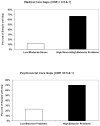Dementia Services Mini-Screen: a simple method to identify patients and caregivers in need of enhanced dementia care services
- PMID: 24315560
- PMCID: PMC4018424
- DOI: 10.1016/j.jagp.2013.11.001
Dementia Services Mini-Screen: a simple method to identify patients and caregivers in need of enhanced dementia care services
Abstract
Objective: Improving dementia care in health systems requires estimates of need in the population served. We explored whether dementia-specific service needs and gaps for patients and caregivers could be predicted by simple information readily captured in routine care settings.
Method: Primary family caregivers (n = 215) rated their own current stress, challenging patient behaviors, and prior-year needs and gaps in 16 medical and psychosocial services. These were evaluated with other patient and caregiver characteristics in multivariate regressions to identify unique predictors of service needs and gaps.
Results: Caregiver stress and patient behavior problems together accounted for an average of 24% of the whole-sample variance in total needs and gaps. All other variables combined (comorbid chronic disease, dementia severity, age, caregiver relationship, and residence) accounted for a mean of 3%, with none yielding more than 4% in any equation. We combined stress and behavior problem indicators into a simple screen. In early/mild dementia dyads (n = 111) typical in primary care settings, the screen identified gaps in total (84%) and psychosocial (77%) care services for high stress/high behavior problem dyads vs. 25% and 23%, respectively, of low stress/low behavior problem dyads. Medical care gaps were dramatically higher in high stress/high behavior problem dyads (66%) than all others (12%).
Conclusion: The Dementia Services Mini-Screen is a simple tool that could help clinicians and health systems rapidly identify dyads needing enhanced dementia care, track key patient and caregiver outcomes of interventions, and estimate population needs for new service development.
Keywords: Dementia; chronic care; health services; screening.
Copyright © 2014 American Association for Geriatric Psychiatry. Published by Elsevier Inc. All rights reserved.
Figures
Similar articles
-
Caregiver- and patient-directed interventions for dementia: an evidence-based analysis.Ont Health Technol Assess Ser. 2008;8(4):1-98. Epub 2008 Oct 1. Ont Health Technol Assess Ser. 2008. PMID: 23074509 Free PMC article.
-
Unmet needs of caregivers of individuals referred to a dementia care program.J Am Geriatr Soc. 2015 Feb;63(2):282-9. doi: 10.1111/jgs.13251. J Am Geriatr Soc. 2015. PMID: 25688604 Free PMC article.
-
Remotely delivered information, training and support for informal caregivers of people with dementia.Cochrane Database Syst Rev. 2021 Jan 4;1(1):CD006440. doi: 10.1002/14651858.CD006440.pub3. Cochrane Database Syst Rev. 2021. PMID: 33417236 Free PMC article.
-
Effectiveness of interventions to improve family-staff relationships in the care of people with dementia in residential aged care: a systematic review protocol.JBI Database System Rev Implement Rep. 2015 Nov;13(11):52-63. doi: 10.11124/jbisrir-2015-2415. JBI Database System Rev Implement Rep. 2015. PMID: 26657464
-
Screening for Cognitive Impairment in Older Adults: An Evidence Update for the U.S. Preventive Services Task Force [Internet].Rockville (MD): Agency for Healthcare Research and Quality (US); 2020 Feb. Report No.: 19-05257-EF-1. Rockville (MD): Agency for Healthcare Research and Quality (US); 2020 Feb. Report No.: 19-05257-EF-1. PMID: 32129963 Free Books & Documents. Review.
Cited by
-
Assessing behavioral and psychological symptoms of dementia: a comprehensive review of current options and future perspectives.Front Dement. 2023 Jul 25;2:1226060. doi: 10.3389/frdem.2023.1226060. eCollection 2023. Front Dement. 2023. PMID: 39082001 Free PMC article. Review.
-
What are the caregivers' needs on dementia care? An integrated qualitative and quantitative assessment.Neurol Sci. 2018 Jun;39(6):1085-1091. doi: 10.1007/s10072-018-3332-3. Epub 2018 Apr 5. Neurol Sci. 2018. PMID: 29623525
-
Nursing students' knowledge about Alzheimer's disease.J Nurs Educ Pract. 2018 Nov;8(11):83-91. doi: 10.5430/jnep.v8n11p83. Epub 2018 Jul 5. J Nurs Educ Pract. 2018. PMID: 39027156 Free PMC article.
-
Informal carers' information needs in managing behavioural and psychological symptoms of people with dementia and related mHealth applications: a systematic integrative review to inform the design of an mHealth application.BMJ Open. 2023 May 11;13(5):e069378. doi: 10.1136/bmjopen-2022-069378. BMJ Open. 2023. PMID: 37169501 Free PMC article.
-
Program of intensive support in emergency departments for care partners of cognitively impaired patients: A randomized controlled trial.Alzheimers Dement. 2025 May;21(5):e70306. doi: 10.1002/alz.70306. Alzheimers Dement. 2025. PMID: 40399761 Free PMC article. Clinical Trial.
References
-
- Chodosh J, Mittman BS, Connor KI, et al. Caring for patients with dementia: how good is the quality of care? Results from three health systems. J Am Geriatr Soc. 2007;55:1260–1268. - PubMed
-
- Odenheimer G, Borson S, Sanders AE, et al. Quality improvement in neurology: Dementia Management Quality Measures. Neurol. 2013 epub ahead of print.
Publication types
MeSH terms
Grants and funding
LinkOut - more resources
Full Text Sources
Other Literature Sources
Medical


